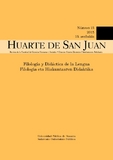Mobile Learning in the Foreign Language Classroom
Keywords:
M-learning; mobile devices, foreign language learning, lesson planAbstract
This paper deals with Mobile learning (m-learning) and how it can be used to teach a second or foreign language in the classroom. First, a review of the use of technology in the classroom is considered. Second, m-learning is defined in connection with diverse educational theories such as behaviourism and constructivism. Third, an exhaustive listing of those features, functionalities and affordances intended specifically to teach a foreign language is provided. Fourth, these characteristics and possible uses are implemented through a lesson plan for Baccalaureate students in which there is an educational use of social networks and mobile devices. Fifth and last, we state some attitudes towards mobile devices across schools and institutions which are holding back their implementation in language classrooms, concluding on a positive note: these new technologies can actually improve language learning.
Downloads
References
Aliende Povedano, I.; Oro Martínez, P. (2009): Mlearning: la formación en tu móvil, La Coruña, NetBiblo.
Ally, M. (2009): «Introduction», en M. Ally (ed.) Mobile Leaning. Transforming the Delivery of Education and Training. Edmonton, AU Press, Athabasca University, pp. 1-8.
Brazuelo Grund, F.; Gallego Gil, D. J. (2011): Mobile Learning. Los dispositivos móviles como recurso educativo, Sevilla, Mad S.L.
Bruner, J. (1966): Toward a theory of Instruction, Cambridge, MA, Harvard University Press. Doi:10.1119/1.2350966.
Camacho, M.; Lara, T. (2011): «M-learning en España, Portugal y América Latina», Monográfico SCOPEO nº 3, Salamanca: Scopeo.
Corbeil, J. R.; Valdes-Corbeil, M. E. (2007): «Are you ready for Mobile Learning?», Educause Quarterly, vol. XXX, nº 2, pp. 51-58. Doi:10.1504/IJMLO.2008.018717.
Cortina-Pérez, B.; Gallardo-Vigil, M.A.; Jiménez-Jiménez, A.; Trujillo-Torres, J. (2014): «Digital illiteracy: a challenge for 21st century teachers», Cultura y Educación, vol. XXVI, nº 2, pp. 231-264.
Council of Europe (2001): Common European Framework of Reference for Language Learning, Teaching and Assessment, Cambridge, Cambridge University Press.
De la Fuente Valentín, L.; Carrasco, A.; Konya, K.; Burgos, D. (2013): «Emerging technologies landscape on education: A review». IJIMAI, vol II, nº 3, pp. 55.
El-Hussein M.; Cronje, J. (2010): «Defining Mobile Learning in the Higher Education Landscape», Educational Technology and Society, vol XIII, nº3, pp.12-21.
Johnson, L.; Smith, R.; Willis, H.; Levine, A.; Haywood, K. (2011): The 2011
Horizon Report, Austin, Texas, The New Media Consortium.
Keegan, D. (2005): «The incorporation of mobile learning into mainstream education and training», World Conference on Mobile Learning, Cape Town. 11. <http://www.mlearn.org.za/CD/papers/keegan1.pdf> (Retrieved 22nd April 2013).
Kolb, L. (2006): Toys to Tools, Washington, ISTE.
Kress, G.; Pachler, N. (2007): «Thinking about the ‘m’ in M-learning», in N. Pachler, (ed.), Mobile Learning: Towards a Research Agenda, London, WLE Centre, Institute of Education, pp. 7-32.
Kukulska-Hulme, A. (2009): «Will mobile learning change language learning?», ReCALL, vol. XXI, nº 2, pp. 157-165.
Kukulska-Hulme, A.; Shield, L. (2008): «An overview of mobile assisted language learning: From content delivery to supported collaboration and interaction», ReCALL, vol. XX, nº3, pp. 271-289.
Mosavi, J.; Miangah, T.; Nezarat, A. (2012): «Mobile Assisted Language Learning» International Journal of Distributed and Parallel Systems, vol. III, nº1, pp.309- 319.
O’Malley, C.; Vavoula, G.; Glew, J.; Taylor, M.; Sharples, M.; Lefrere, P. (2003): «Guidelines for learning/teaching/tutoring in a mobile environment». MOBIlearn project deliverable. [Available at <http://www.mobilearn.org/download/results/guidelines.pdf>] (Retrieved 10th October 2015).
Pachler, N.; Bachmair, B.; Cook, J. (2010): Mobile Learning: Structures, Agency, Practices, London, Springer.
Quinn, C. (2000): «mLearning: Mobile, Wireless, in your Pocket Learning» [Available at <http://www.linezine.com/2.1/features/cqmmwiyp.htm>] (Retrieved 22nd April 2015).
Real Decreto 1467/07, de 2 de noviembre, por el que se establece la estructura del bachillerato y se fijan sus enseñanzas mínimas. [Available at <http://www.boe.es/boe/dias/2007/11/06/pdfs/A45381-45477.pdf>].
Reinders, H. (2010): «Twenty Ideas for Using Mobile Phones in the Language Classroom», ELT Forum nº3, pp.20-33.
Richards, J.; Rodgers. T. (2001): Approaches and Methods in Language Teaching, Cambridge, Cambridge University Press. Doi:10.1017/CBO9780511667305.004.
Texas: The New Media Consortium. [Available at <http://michaeledwardkutch.com/uploads/3/3/1/6/3316493/2013-horizon-report-museum-en.pdf>.].
Traxler, J. (2010): «Education and the Impacts of Mobiles and Mobility», Medienbildung in Neuen Kulturräumen Berlin, VS Verlag für Sozialwissenschaften, pp. 101-111.
Traxler, J. (2005): «Defining Mobile Learning», paper presented at the IADIS International Conference Mobile Learning, 261-266. [Available at <http://www.academia.edu/2810810/Defining_mobile_learning>] (Retrieved 15th October, 2014).
Warschauer, M.; Whittaker, F. (2002): «The Internet for English Teaching: Guidelines for Teachers», in J. Richards and W. Renandya (eds.), Methodology in Language Teaching: An Anthology of Current Practice, Cambridge, Cambridge University Press, pp. 368-383.
Williams, M.; Burden, R. (1999): Psychology for Language Teachers, Cambridge, Cambridge University Press.
Zhao, Y. (2005): Research in Technology and Second language Learning: Developments and Directions, Greenwich, CT, Information Age Publishing, Inc.
Downloads
Published
How to Cite
Issue
Section
License
All articles are published under a Creative Commons (BY-NC-ND 4.0) license. Each article will be assigned a DOI.
Authors retain copyright of their work and grant the journal the right to the first publication. Authors can sign additional agreements to non-exclusive distribution of the published version of the article (for example, in an institutional repository) as long as appropriate attribution to the original publication is provided. Articles can be uploaded to institutional repositories immediately after publication.
Electronic distribution of the articles (for example, academic social networks or personal webpages) is allowed and encouraged.
The journal reserves the right to publicise the work in social networks and other electronic means.







